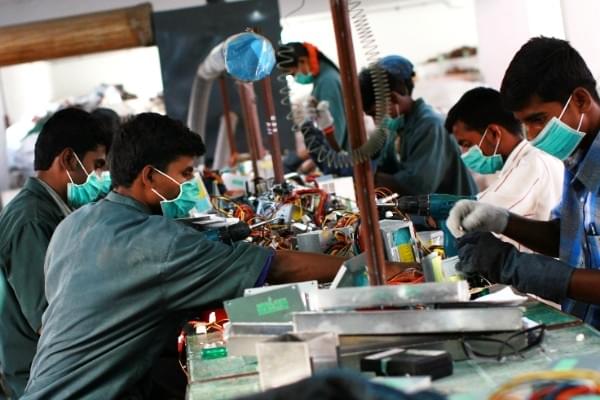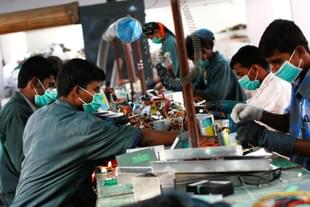Economy
How To Restart The Economy In 21 Days
Arihant Pawariya
Mar 26, 2020, 07:58 PM | Updated 07:58 PM IST
Save & read from anywhere!
Bookmark stories for easy access on any device or the Swarajya app.


Today (26 March) is the fifth day of lockdown across India. Barring a few instances of defiance here and there, crores of people are amazingly adhering to the call of “social distancing” by Prime Minister Narendra Modi, who pleaded with Indians to stay home and do only one thing for the next 21 days: stay home.
The economic costs of such a huge ‘sudden but desperately needed’ step cannot be wished away. Crores of poor people, who live hand to mouth and depend on daily earnings to meet basic needs, will be most affected.
As factories and firms halt production and put a brake on services, many could be laid off. The longer the lockdown, the more severe the economic costs, which eventually will have human costs as well.
Many countries are facing this choice of whether to put brakes on the economy in order to stop Covid-19 or to let the virus spread while keeping the economy running. US President Donald Trump tweeted saying that the cure cannot be worse than the disease.
“We have to open our country because that causes problems that, in my opinion, could be far bigger problems,” he says.
Is the cure (putting whole cities/states/countries in full lockdown) really worse than the disease? No. As Thomas Pueyo explains in this wildly popular article that epidemics like Covid-19 can be controlled with a “hammer and dance” approach.
Basically, it’s all about the rate of transmission (R). The goal is to keep it below one — meaning that an infected person is able to infect only one person or less (on average).
In Wuhan, initially, R was 3.9 — that is one person was infecting almost four people and those four people could transmit the virus to 16 and so on. If R is above one, the growth in cases is exponential. Less than one, and you have a situation which can be controlled easily.
So, the immediate focus must be to take R to below one. This requires harsh steps which Pueyo is referring to as the hammer. The more one waits, the heavier and longer the hammer, he says.
So, India with around 600 cases will need to apply the hammer (lockdown) for much less time than the US which has 100 times more cases. Even today, the lockdown in the US is far more relaxed compared to what India has done.
The more the US delays, the heavier the price it will pay. It took China two months to partially lift the lockdown in Hubei, the epicentre of coronavirus. Situation in the US is far more alarming and its President is already flirting with the idea of opening the country without even properly closing it.
One thing is clear that the ‘hammer and dance’ strategy is the best way out to beat the pandemic as China, South Korea, Singapore and Taiwan have shown. Even if they see a second mini wave of new cases, this could be managed much better and at a much lower cost than the costs the countries which have let the situation worsen are bearing.
What should India do? Thankfully, the central government has used the hammer (in form of travel restrictions, screening at the airports, quarantining thousands, contact tracing of the infected) much more sincerely than the Western countries. And it decided to go all in when it had only 500 cases and 10 deaths.
It means we would have much easier time controlling the epidemic than anyone else (given the 21-day curfew goes smoothly). Then we can start opening the economy in 21 days (or earlier) and put the country back to work.
Though, full national lockdown is the most effective measure towards that goal, it must be complemented with other necessary steps without which we could fail and prolong the economic pain.
Here is what we should do now (the 21-day lockdown is the best time to execute).
First, we must scale up testing. But not do so indiscriminately. We should zero in on the worst-affected districts and states. Tens of thousands of tests should be carried out daily in these states and districts alone, over and above what the labs in other parts of the country do.
More importantly, home testing should take place. All the government employees — including non-health workers (below 40 years of age) can be quickly enrolled and trained to collect samples randomly from each and every locality of an affected city or the district cluster, and then fan out in nearby villages.
Since most of the people are at home for the next 20 days, this would be an easier exercise to pull off.
The idea is to stop the infected people from rushing to the hospitals for checkup and infect others in the process.
Another stakeholder that needs to be protected is the healthcare worker. They should be regularly tested so that they don’t become bio weapons themselves. We have seen how a Mohalla Clinic doctor got infected via a patient and came in contact with around 800 people. Similarly, a nurse in Gurgaon has tested positive. Avoiding these situations must be a priority.
Doing limited testing when India was sure that community transmission had not taken place was a prudent strategy but now there have been cases after which doubts have emerged if we are still in the local transmission stage. We can’t afford to wait. Nor can we afford to start mass testing on a national scale. But we can certainly start from the worst-affected ones.
This could be done by the government authorities as well as by prioritising giving licence to private labs located in these worst-affected areas. Both need to come together to pull this off.
Second, testing massively and at home is critical to start opening the country. It does two things.
First, it will help nail the problem fast which is of great importance as it reduces the rate of transmission further (the lockdown is already a big plus).
If someone has Covid-19 and he gets to know about it after a week, he would have infected four-five people but with mass testing, he could be detected early and isolated preventing further spread.
Second, mass testing allows the government to know for sure whether the spread is actually slowing or not.
Once the trend is known, districts or a cluster of districts (or even a whole state) can be categorised into layered zones — red, yellow and green — as per their risk profile. This idea was suggested a week ago by Balaji Srinivasan, an angel investor and entrepreneur.
He recommended it for the US but it suits a country like India where it’s much easier to execute at a national scale.
A green zone is a geographic area with comprehensive testing that demonstrates no new cases within the past four weeks.
— Balaji S. Srinivasan (@balajis) March 19, 2020
A red zone is everywhere else.
This can be done at the state level as well. Let’s say that on the national map, Haryana is one of the 10 most-affected states. Let’s declare it as the ‘red’ zone. But when we look at Haryana separately, we may find that 60 per cent districts have zero cases. We can put them in the ‘green’ zone — the virus free districts. This exercise can be carried out in all the states similarly.
Third, once we have these zones demarcated and colour coded, we can let the people out of curfew and restart normal life there again as Srinivasan suggests. But this has to be done by following strict controls and there the smallest unit has to be a district and largest — state as independent executive decisions can be taken at those levels.
The ‘red’ districts can be cordoned off with curfew-like situations and strict controls over movement. For ‘yellow’ districts, the controls can be slightly relaxed. For ‘green’ ones, full freedom can be extended.
This will ensure that a) the policing resources are better utilised and b) less strain on medical resources with much better management and c) economic activity can carry on in a large part of the country, which will not cause severe loss but also help the government in targeting for benefits only those people who are worst affected by the lockdown.
As of today (26 March), there are eight states and union territories which don’t have a single case of Covid-19. These need not be in lockdown and economic activity can resume there. Additionally, going further, Indian states can start relaxing curfews in scores of districts one week or 10 days from now if we play it smart.
We need to give vast powers to district and state administration to act as independent islands of jurisdictions so that they can decide on who is allowed to come inside or go outside. At a time when there is total ban on railways, state transport buses and other modes of public transport, such movements at local level are easier to implement.
The bottomline is if the states and the central government play it well, the economic loss of the lockdown can be severely limited and large parts of the economy can be quickly opened.
Once we have all the cases identified and isolated, we can get the whole country out of lockdown.
Inter-state transport and railways can start operations. Only international travel will have to remain under suspension for the foreseeable future. But that’s the price we must be ready to pay: sacrificing the commercial aviation industry in order to save the whole economy.
Fourth, and perhaps the most important is to arm the vast population and the workplaces and transport systems with tools to significantly reduce the risk once red and yellow districts return to normal operations. This should involve producing at least 100 crore masks in the next one month with both the private and public sector pitching in. In the US, Apple Inc. alone is donating 90 lakh masks.
Another issue is to make Personal Protection Equipment available to all healthcare workers and not just the ones in charge of treating Covid-19 patients. The government must get cracking on ramping up its ventilators capacity. Indian government should look to double the present capacity at the very least.
The chief purpose of using the hammer is to buy time and boost healthcare capacity in the short term. If we don’t do that, we will be forced to remain in the lockdown phase for longer periods of time than is warranted.
Arihant Pawariya is Senior Editor, Swarajya.





